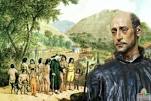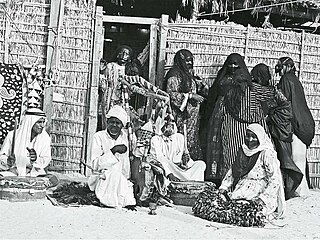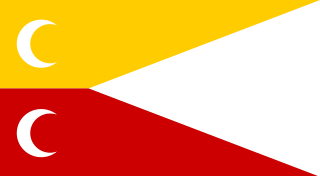Related Research Articles

João de Barros, nicknamed the "Portuguese Livy", is one of the first great Portuguese historians, most famous for his Décadas da Ásia, a history of the Portuguese in India, Asia, and southeast Africa.

Kilwa Kisiwani is an island, national historic site, and hamlet community located in the township of Kilwa Masoko, the district seat of Kilwa District in the Tanzanian region of Lindi in southern Tanzania. Kilwa Kisiwani is the largest of the nine hamlets in the town of Kilwa Masoko and is also the least populated hamlet in the township with around 1,150 residents.
The Swahili people comprise mainly Bantu, Afro-Arab, and Comorian ethnic groups inhabiting the Swahili coast, an area encompassing the East African coast across southern Somalia, Kenya, Tanzania, and northern Mozambique, and various archipelagos off the coast, such as Zanzibar, Lamu, and the Comoro Islands.

Zanj is a term used by medieval Muslim geographers to refer to both a certain portion of Southeast Africa and to its Bantu inhabitants. It has also been used to refer to East Africans collectively by Arab sources. This word is also the origin of the place-names Zanzibar and the Sea of Zanj.
Pedro de Sintra, also known as Pero de Sintra, Pedro da Cintra or Pedro da Sintra, was a Portuguese explorer. He was among the first Europeans to explore the West African coast. Around 1462 his expedition reached what is now Sierra Leone and named it. Although according to professor C. Magbaily Fyle this could have possibly been a misinterpretation of historians; there has been evidence of Serra Lyoa being mentioned prior to 1462, the year when de Sintra's expedition reached the coast of Sierra Leone. This would suggest that the person who named Sierra Leone is still unknown. However, if de Sintra did name the area, it is unclear whether he named it after the landforms or climate in the area. According to some the coastal regions resembled lion's teeth while others suggest the thunderstorms sounded like the roar of a lion. Sixteenth century English sailors called the area Sierra Leoa which later evolved to Sierra Leone in the 17th century. The British, prior to the area being colonised, officially adopted the name Sierra Leone in 1787.
António da Madalena was a Portuguese Capuchin friar who was the first Western visitor to Angkor in 1586.

Pate (Paté) Island is located in the Indian Ocean close to the northern coast of Kenya, to which it belongs. It is the largest island in the Lamu Archipelago, which lie between the towns of Lamu and Kiunga in the former Coast Province. The island is almost completely surrounded by mangroves.

Cristóvão de Mendonça was a Portuguese noble and explorer who was active in South East Asia in the 16th century.

Sofala, at present known as Nova Sofala, used to be the chief seaport of the Mwenemutapa Kingdom, whose capital was at Mount Fura. It is located on the Sofala Bank in Sofala Province of Mozambique. The first recorded use of this port town was by Mogadishan merchants. One possible etymology for Sofala is "go and cultivate" in the Somali language, showing the city as a hub for gold.

Afro-Arabs, African Arabs, or Black Arabs are Arabs who have predominantly or total Sub-Saharan African ancestry. These include primarily minority groups in the United Arab Emirates, Yemen, Saudi Arabia, Oman, Kuwait, Qatar, Bahrain, Lebanon, Syria, Palestine, Jordan, Iraq, Libya, Western Sáhara, Tunisia, Algeria, and Morocco. The term may also refer to various Arab groups in certain African regions.

Swahili culture is the culture of the Swahili people inhabiting the Swahili coast. This littoral area encompasses Tanzania, Kenya, and Mozambique, as well as the adjacent islands of Zanzibar and Comoros along with some parts of Malawi and the eastern part of Democratic Republic of Congo. Swahili people speak Swahili as their native language, which belongs to the Bantu language family. Graham Connah described Swahili culture as at least partially urban, mercantile, and literate.

The Kilwa Sultanate was a sultanate, centered at Kilwa, whose authority, at its height, stretched over the entire length of the Swahili Coast. According to the legend, it was founded in the 10th century by Ali ibn al-Hassan Shirazi, a Persian prince of Shiraz.
António de Saldanha was a Castilian-Portuguese 16th-century captain. He was the first European to set anchor in what is now called Table Bay, South Africa, and made the first recorded ascent of Table Mountain.

The Swahili coast is a coastal area of East Africa, bordered by the Indian Ocean and inhabited by the Swahili people. It includes Sofala ; Mombasa, Gede, Pate Island, Lamu, and Malindi ; and Dar es Salaam and Kilwa. In addition, several coastal islands are included in the Swahili coast, such as Zanzibar and Comoros.
The Third Portuguese India Armada was assembled in 1501 upon the order of King Manuel I of Portugal and placed under the command of João da Nova. It was small compared to other armadas of the same type and was formed for commercial purposes. Nonetheless, it engaged in the first significant Portuguese naval battle in the Indian Ocean. The Third Armada discovered the uninhabited islands of Ascension and Saint Helena in the South Atlantic Ocean. Some speculate that it was the first Portuguese armada to reach Ceylon.
The Shirazi people, also known as Mbwera, are a Bantu ethnic group inhabiting the Swahili coast and the nearby Indian ocean islands. They are particularly concentrated on the islands of Zanzibar, Pemba and Comoros.
The 1505 expedition of Pêro de Anaia to Sofala led to the establishment of Fort São Caetano, the first permanent Portuguese colony in East Africa. The Capitaincy of Sofala would eventually evolve into the colonial government of Portuguese Mozambique.

The "Shirazi era" refers to a mythic origin in the history of Southeast Africa, between the 13th century and 15th century, as recorded in the 15th century Kilwa Chronicle. Many Swahili in the central coastal region claim that their towns were founded by Persians from the Shiraz region in the 13th century.
Gonçalo de Sintra or de Cintra (d.1444/45), was a 15th-century Portuguese explorer and servant of Prince Henry the Navigator.
Décadas da Ásia is a history of the Portuguese in Asia and southeast Africa collected and published by João de Barros between 1552 and 1563, while living abroad. His work was continued by Diogo do Couto and João Baptista Lavanha.
References
- 1 2 3 Delmas, Adrien (2017). "Writing in Africa: The Kilwa Chronicle and other Sixteenth-Century Portuguese Testimonies". In Brigaglia, Andrea; Nobili, Mauro (eds.). The Arts and Crafts of Literacy: Islamic Manuscript Cultures in Sub-Saharan Africa. Berlin, Boston: De Gruyter. p. 189. ISBN 9783110541441. OCLC 1075040220.
- ↑ Brielle, Esther S.; Fleisher, Jeffrey; Wynne-Jones, Stephanie; Sirak, Kendra; Broomandkhoshbacht, Nasreen; Callan, Kim; Curtis, Elizabeth; Iliev, Lora; Lawson, Ann Marie; Oppenheimer, Jonas; Qiu, Lijun; Stewardson, Kristin; Workman, J. Noah; Zalzala, Fatma; Ayodo, George (March 2023). "Entwined African and Asian genetic roots of medieval peoples of the Swahili coast". Nature. 615 (7954): 866–873. Bibcode:2023Natur.615..866B. doi:10.1038/s41586-023-05754-w. ISSN 1476-4687. PMC 10060156 . PMID 36991187.
- ↑ Kusimba, Chapurukha; Reich, David. "Ancient DNA is restoring the origin story of the Swahili people of the East African coast". The Conversation. Retrieved 31 March 2023.
- ↑ "Who Were the Sultans of the Swahili Culture?". ThoughtCo. Retrieved 22 October 2024.